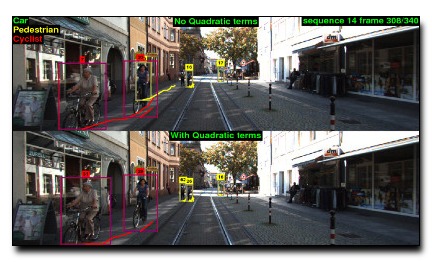
We describe an end-to-end framework for learning parameters of min-cost flow multitarget
tracking problem with quadratic trajectory interactions including suppression of
overlapping tracks and contextual cues about co-occurrence of different objects. Our
approach utilizes structured prediction with a tracking-specific loss function to learn the
complete set of model parameters. Under our learning framework, we evaluate two different
approaches to finding an optimal set of tracks under quadratic model objective
based on an LP relaxation and a novel greedy extension to dynamic programming that
handles pairwise interactions. We find the greedy algorithm achieves almost equivalent
accuracy to the LP relaxation while being 2-7x faster than a commercial solver. We evaluate
trained models on the challenging MOT and KITTI benchmarks. Surprisingly, we
find that with proper parameter learning, our simple data-association model without explicit
appearance/motion reasoning is able to outperform many state-of-the-art methods
that use far more complex motion features and affinity metric learning.
Download: pdf
Text Reference
Shaofei Wang and Charless C. Fowlkes.
Learning optimal parameters for multi-target tracking.
In
British Machine Vision Conference (BMVC). 2015.
BibTeX Reference
@inproceedings{WangF_BMVC_2015,
author = "Wang, Shaofei and Fowlkes, Charless C.",
title = "Learning Optimal Parameters for Multi-target Tracking",
booktitle = "British Machine Vision Conference (BMVC)",
year = "2015",
tag = "object_recognition"
}
